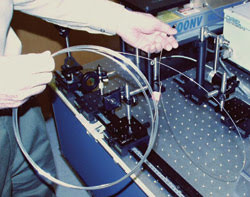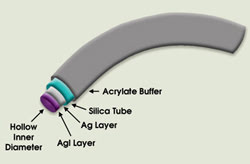James P. Clarkin, Polymicro Technologies LLC
Applications in the mid- and far-infrared regions have long suffered from the lack of a reliable, cost-effective means of guiding optical power in an optical fiber or other flexible waveguide. Many systems still depend on line-of-sight configurations, lensing and mirrors, or cumbersome articulated arms. This severely limits the scope of potential applications, particularly remote spectroscopy, minimally invasive surgical procedures, and CO2 laser materials processing and printing. Flexible hollow silica waveguides offer a solution to this problem.
These waveguides are hollow silica tubes with inner diameters of typically 300 to 1000 μm. The inner surface is coated with a silver mirror finish and then with silver halide, creating a very efficient dielectric reflector for infrared wavelengths.
This approach provides a means of transporting infrared power in the 2.9- to 20-μm region and is particularly well-suited for 9- to 11-μm CO2 and 2.9-μm Er:YAG lasers. Typical attenuation at 10.6 μm for a 1000-μm-inner-diameter waveguide is less than 0.5 dB/m. The waveguides can handle up to 100 W at CO2 wavelengths without external cooling and more than 1000 W with external cooling.
In power applications, the key operational issue is establishing the launch conditions for the particular laser system being used. Previously, most users developed a launch system specific to the application, but several companies are developing launch adapters for common lasers. The launch conditions should be at a low angle (f number greater than 20) and should be well-aligned with the open area of the inner diameter so that the optical energy does not impinge the silica or outer protective jacket — optimally, approximately 65 percent of the bore aperture. Being a hollow tube, a waveguide does not display the front-surface issues seen with solid optical fibers and lenses, so the theoretical maximum input coupling efficiency is 100 percent.

Flexible hollow silica waveguides are a reliable, cost-effective means of guiding infrared optical power for applications such as remote spectroscopy, minimally invasive surgery, materials processing and printing.
Hollow silica waveguides are also finding application in remote infrared spectroscopy. The waveguides are used in two ways: The first involves the remote transfer of the optical power from the location being sensed to the spectrometer — for example, from a chemical or gas stream or from a turbine engine for heat sensing; the second uses the waveguide itself as a gas or fluid sensor cell. In this mode, the sample is injected or drawn into a coiled waveguide, and the infrared absorption spectrum reveals the presence and quantity of certain materials in the gas stream. The coil of waveguide effectively results in a very long, yet compact, sensor cell. In spectroscopy, the waveguides perform quite well. Alignment is less of an issue because the power levels are low, but collection of the signal may be an issue because the waveguides operate at a low effective numerical aperture of 0.05 to 0.1.

The inner surface of the hollow silica waveguide is coated with a silver mirror finish and then with silver halide to yield an efficient infrared dielectric reflector. A 1000-μm-inner-diameter waveguide displays a typical attenuation of less than 0.5 dB/m for 10.6-μm radiation.
The cost of a hollow waveguide ranges from $150 to $700 per meter for low to moderate quantities, depending on the size and type. The manufacturing process is inherently inexpensive, however, so pricing for higher volumes may approach $50 per meter.
Initially, licensing issues hampered the adoption of hollow waveguide technology, and certain applications and wavelengths were restricted — particularly medical and veterinary CO2 laser applications. This obstacle recently was removed, and the waveguides are available for use with any application or wavelength. In addition, scientists are developing hollow waveguides with an aluminum inner coating that would be suitable for transmitting 170- to 350-nm ultraviolet radiation.
Meet the author
James P. Clarkin is vice president of business development at Polymicro Technologies LLC in Phoenix; e-mail: [email protected].